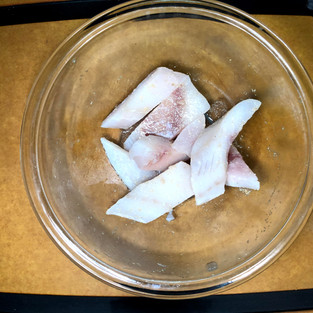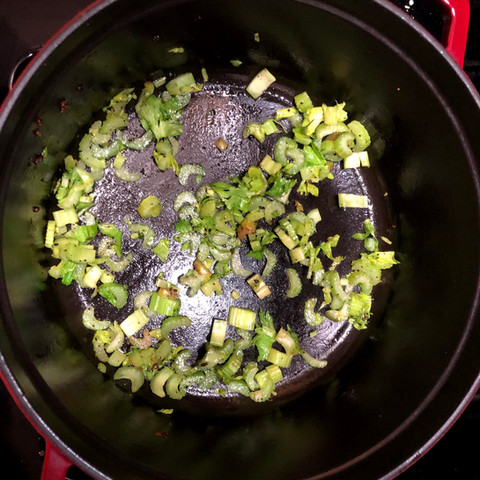Sichuan Boiled Fish
- Samantha Lewis

- Apr 20, 2021
- 6 min read
Using Sitka Salmon Shares Alaskan Sea Bass cooked in seasoned sichuan pepper and soy soup base topped with herbs and spices -

The Chinese name for sichuan boiled fish translates into water boiled fish. I've never prepared any fish by just boiling it. I usually take the pan fried or baked route like many of you, but one day while the weather was still pretty cold, I was in the mood for a hot noodle soup. I believe I googled "asian noodle soup recipe" and came across this one on pinterest. I can only follow recipes as closely as my brain would allow me before I begin altering and modifying it with my cooking style, taste profile, and the ingredients I have on hand.
SITKA SALMON SHARES
The great thing about using Sitka Salmon Shares vacuum frozen fish filets is that they defrost so easily and don't leave your fish feeling mushy or filled with water like your typical frozen fish. Sitka Salmon Shares remains fresh even after defrosting. You can take the fish out the freezer the same day and it will defrost enough in an hour to two hours. For best results with this recipe, use a fresh fish filet. When ordering this dish in a traditional Chinese restaurant, they are pulling from their live fish tanks and providing a high quality meal from the whole fish.

HOW IS SITKA SALMON SHARES CHANGING THE WAY AMERICANS EAT FISH?
Sitka Salmon Shares is working to shift the seafood industry towards a system that is more responsible, transparent, ethical and higher quality. The company partners with local fishermen who then receive up to 30% more for their harvest versus supplying directly to large chain grocery stores. These fishermen or women follow Alaska’s sustainable fisheries management system, which is the strictest in the world ensuring that your fish is traceable back to the source. Studies published by CNN state that between 20 and 60 percent of U.S. fish is mislabeled. These bad practices show us that the industry would rather put profits ahead of our habitats, fishermen, and health, which is why Sitka Salmon Shares is committed to educating their consumers about the process of harvesting and distributing fish sustainably.
Since receiving my first Sitka Salmon Shares box, I have not purchased fish from another source. The quality is unmatched with anything I've had "locally" for a price that works for me.
Now, get a premium, seasonal fish delivery sent right to your door.
Take $25 off your order of a Sitka Salmon Premium Share using code "BWS" at checkout.

TINGLY AND NUMBINGLY HOT
I previously purchased sichuan peppercorns after tasting the best kung pao chicken at an event at the Museum of Food and Drink. I spent the summer and fall of 2019 volunteering with the museum and eventually getting the opportunity to run their social media account. MOFAD hosts a number of events a week related to food and agriculture. Their recent exhibit, which began in 2016, was titled CHOW: MAKING THE CHINESE AMERICAN RESTAURANT. The goal was to educate their audience on the migration of Chinese immigrants in the 1800s leading up to their influence on food and the Chinese-American restaurant. I spent many weekends learning and tasting so many different Chinese dishes, sauces and spices. I always took what I was learning at the museum home and tried to recreate dishes in my kitchen so I knew at some point I would try to recreate that kung pao chicken.
Sichuan peppercorns are hot! Yet, they complement sweet tastes very well. They are so spicy, but what makes them unique is the tingly, numbing feeling you get all around your mouth. You can create a delicious snack using roasted peanuts, little sesame oil, sichuan peppercorns, and a sprinkle of sugar.
The recipe by Red House Spice calls for three different spicy ingredients to give it the full bodied flavor: dried chilli, Sichuan chilli bean paste and chilli powder.
I slightly modified and added the sichuan peppers in addition to the other spices.
Thoroughly seasoning the water before adding the fish, and letting it simmer on low helped infuse the fish cuts with all the spices and deep flavors.
SUPER SIMPLE AND NO FUSS TO PREPARE
I know many of my followers get intimidated about cooking fish. I do my best to show my fish recipes as simply as possible and in as little steps as I can. Fish is so easy to make and unlike meat, in my opinion, it's less stress on making sure it's cooked properly to avoid sickness.
Since the fish will be simmering in the hot soup base, I can guarantee that cooking will be easy peasy. Once the base is ready and hot, drop the fish cuts in, lower the heat so it's still bubbly but not pouring out with the lid on, and let sit.
For this recipe, it will be best to prep all your ingredients first and have them set up for when you are ready to use them.

INGREDIENTS
Sitka Salmon Shares Wild Alaskan Sea Bass, skinless, boneless fish fillet
1/4 cup rice wine vinegar
2 tbsp corn starch
egg noodles
Chili Peppers
1/2 tsp cooking oil
15 dried dried chili arbole
2 tsp Sichuan peppercorn
Broth
2 tbsp cooking oil, sesame oil adds the best flavor
3 garlic cloves, roughly chopped
1 tbsp ginger, chopped
1-2 stalk scallions, chopped
1.5 tbsp Sichuan chilli bean paste (chili powder or another spicy seasoning will work as a substitute too, be mindful of saltiness)
2 cups water plus a chicken bouillon seasoning cube or adobo seasoning
Garnishing
chopped celery
scallions
handful of cilantro
Sichuan Boiled Fish
1. Clean and marinate your fish
First step, remove your fish from the package and give it a good rinse. You can use any white fish to prepare this recipe; shrimp, scallops, cod, etc.
Pat fish dry to remove excess water and place in a large bowl. Add a sprinkle of salt, 1/4 cup rice wine vinegar, and a tablespoon of cornstarch. Stir until mixed well. Wrap the bowl with plastic wrap and place in the fridge.
2. Frying the chilis
I used my dutch oven for this recipe, but traditionally you would prepare in a wok. A wok was actually my first cooking utensil when I moved to New York. It boils water, fries, sautees. It was the perfect first pot that did everything I needed!
Use a deep pan to fry the dried chilis and Sichuan peppercorns in oil over very low heat. It's very easy to burn the peppers so watch it like a hawk, stirring occasionally until you begin to smell them. Remove from pot and coarsely chop when cooled.

3. Toasted celery
In the same pan, heat a little oil over medium heat and toast celery. Cook for about a minute and a half. Remove and set aside.
4. Make your own quick-broth
In the same pan, I used my dutch oven for this whole meal, add a little more oil. This is how I make a quick broth instead of using canned broth. Both options work great.
Add chopped garlic, ginger and spring onion to the heated oil. Add Sichuan chilli bean paste and stir. Pour in water and stir until combined well. Bring mix to a full boil.
Congrats! You're making broth!
5. Time to cook the fish
Gently place the fish slices into the broth. Let sit for about 10 minutes. You can add noodles to your boiling water, leave it to eat as soup, serve with rice, or add a handful of greens. Add your celery back into the mix.
6. Garnishing
Top with lots of herbs and sesame oil. Serve immediately.
Chinese inspired dishes became a staple in my kitchen. When I first moved to New York I forced myself to learn how to cook. I read a lot of recipes and scrolled through a lot of pins on pinterest. The first neighborhood I lived in was actually Chinatown, Manhattan. I was 5 steps away from some of the best duck dishes, noodle soups, dumplings, etc., and having access to the grocery stores to be able to recreate my favorite dishes helped make learning how to cook fun. As a beginner home-chef, simple meals with a lot of flavor was my style. This boiled fish recipe holds so much flavor and is prepared by just boiling water. It can't get more simple than that!
Enjoy!






























Comments